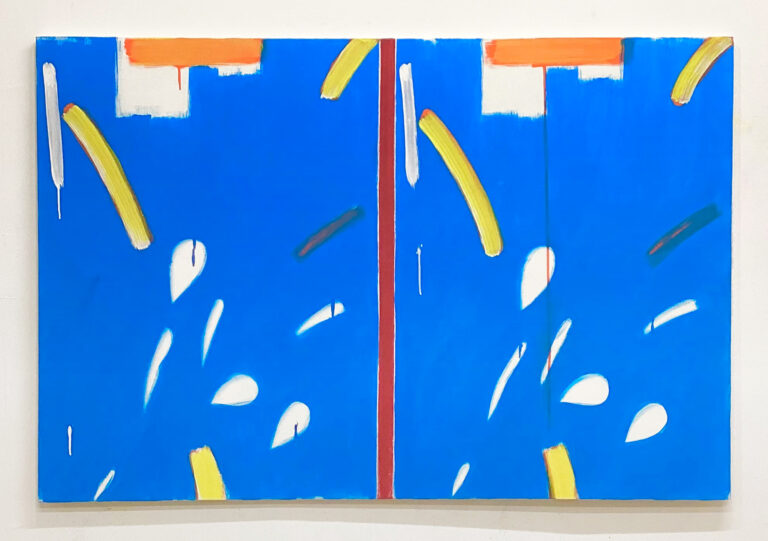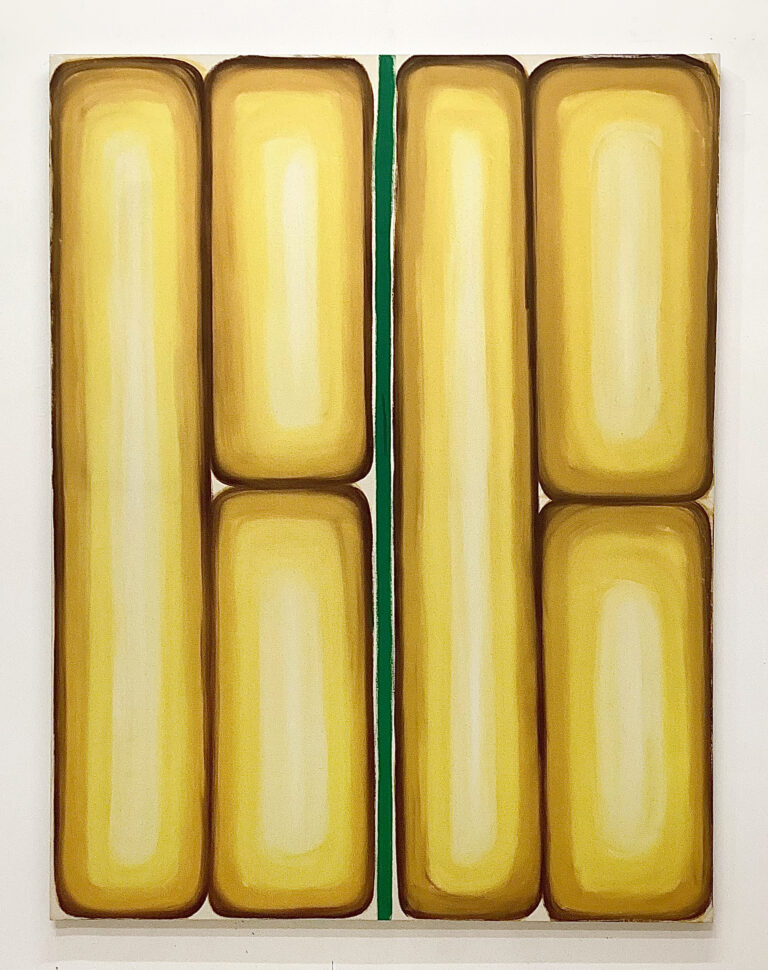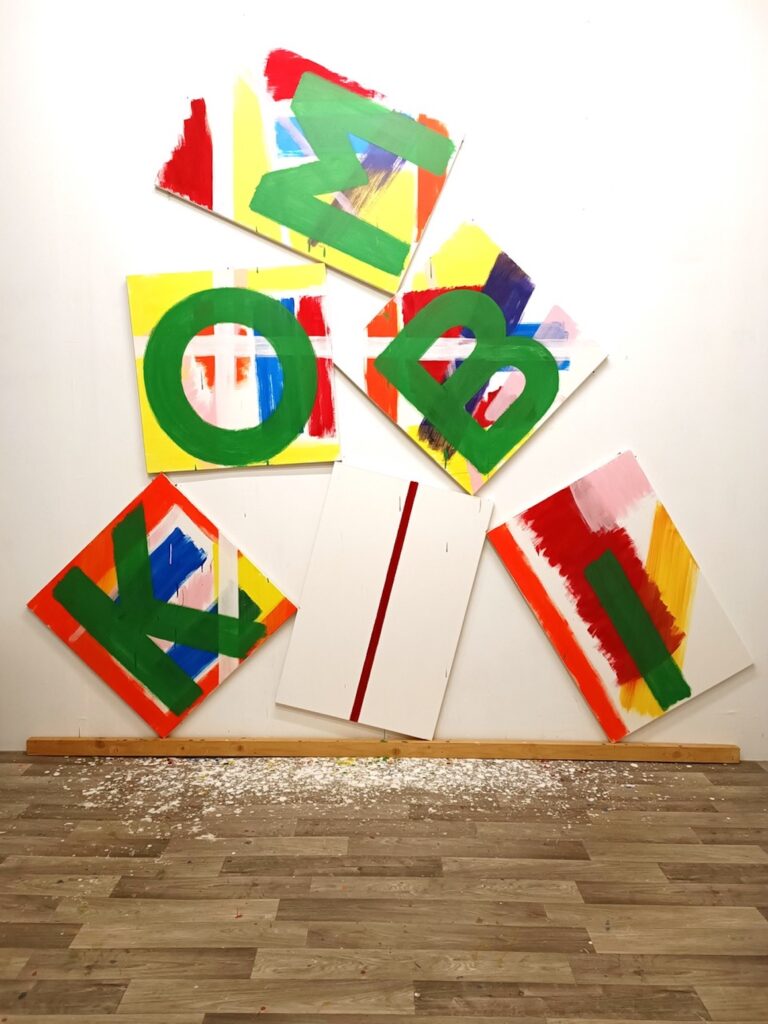Bernard Piffaretti
Kombi
Gallery Openings—15 Sep 2023, 6 to 9 PM
Bernard Piffaretti (b. 1955 in St Etienne, lives in Paris) belongs to the central positions in the field of conceptual, contemporary painting. Since the late 1980s, his work has been determined by the idiosyncratic principle of repetition—the establishment of the ‘image double’, which finds its unity on the canvas.
At the origin of each work, Piffaretti follows a fixed protocol. As a première geste, the artist sets a vertical, coloured line. On one side of the canvas—thus divided in the middle—the pictorial idea is developed, which is subsequently realised a second time on the other side. This happens with immense formal and compositional security, without technical aids, swiftly, and confidently.

Bernard Piffaretti, Sans titre, 2023, acrylic on canvas, 97 x 146 cm
While a copy would be doomed to failure, Piffaretti’s work is concerned with the transitory momentum that comes into effect through the presence of a visual dividing line. This conceptual approach not only enables a surprisingly concrete awareness of the painting process and of the ‘becoming of the picture’ per se, but simultaneously creates thoughtful distance to the seemingly spontaneous yet formally precise painting style. With this peculiar methodology, Piffaretti strikingly succeeds in raising the most diverse questions deeply connected with the medium of painting.
Kombi is the title of Bernard Piffaretti’s fourth solo exhibition at Klemm’s. The intellectual starting point is a playful yet distanced reflection on the once emblematic and still popular function of the ‘Kombi’ (Kombinationswagen) and the possibility offered through its multiple uses to discover the world.
Piffaretti combines this concept both spatially and temporally over the course of the exhibition with the idea of a traditional “Cabinet of Curiosities”: his painterly repertoire can be explored by the viewer in a wide variety of ways—right down to the ‘iconographic’ margins of his canvases.
Bernard Piffaretti proposes a personal collection—a ‘painting cabinet’—of his own paintings, in which his works are exhibited, as it were, as ‘rarities’ and ‘curiosities’; anchored per se in the author’s consciousness and memory, they also acquire a certain familiarity with the viewer through the reiterated gestural expressiveness of their creative act.
It is not without a certain irony that the artist seems to place himself in a role traditionally associated with that of the collector: through this peculiar exhibition display, subjective virtues and values are ascribed to his pictorial archive—and it is precisely the critical questioning of uniqueness, of this original ‘moment of surprise’, that has been a constant basis in Piffaretti’s very own ouevre.
Bernard Piffaretti’s “Wunderkammer”, presented in Kombi, categorises its ‘notable objects’ according to their temporality and formal peculiarities. A group of paintings from the 1990s is followed by another recent complex of works from 2022/2023; the “naturalia” section of the cabinet revisits the almost totemic character of the figures from Piffaretti’s painterly repertoire.
Another conceptual anchor of the exhibition is the fragmentation and displacement of a “meta-painting”: an early-established painterly gesture and ever present in Piffaretti’s exhibitions (in the function of the proverbial titular picture in a tableau) here dissolved into individual elements, brought to the wall like a search image or rebus.

Bernard Piffaretti, Sans titre, 1995, acrylic on canvas, 183 x 138 cm

Bernard Piffaretti, Sans titre, 2023, acrylic on canvas, 97 x 146 cm
As per protocol, the various works and related aspects from the artists’ archive and recent studio practice are shown in the gallery in weekly rotation; for this purpose, Bernard Piffaretti resorts to a ‘storage unit’, conceived and designed by him. Between a transport crate and static architecture, this element on the one hand serves as ‘storage’ for the pictures already shown or still waiting to be displayed. On the other hand, its intrinsic functionality, which is not clearly named, is to offer precisely this dynamic viewing experience also inherent in the individual works.
Piffaretti’s pictures populate the gallery space as stages of a journey, following the same, repetitive gesture that seems to achieve something but never quite succeeds. The process seems to be the goal here: it is precisely the ever-visible slight deviations, the drippings, inaccuracies, ‘mistakes’ and the small, formal differences that not only draw the two halves of the painting together, but generate the contextual stage that enables Piffaretti to incorporate a wide variety of painterly content and to bring it on the canvas over time with formal continuity.
If in previous solo shows at Klemm’s Piffaretti had challenged the reconstruction of a temporality in his works—first addressing the impossibility of a temporal evolution in his oeuvre with No Chronology (Klemm’s, 2016)—hen deliberately subjecting his aesthetic expression to a chronological evolution in Kontinuum (Klemm’s, 2019)—in Kombi he engages with yet another form of recategorisation of his pictorial archive: presenting a non-temporal but a rather ‘formal’ clustering of works.
The fil rouge in Bernard Piffaretti’s work lies in the complete freedom and openness inherent in the artist’s proposals, without becoming arbitrary, each painting is consolidated by its duplication and repetition, which in turn raises the ever-unresolved question regarding its belonging in the realm of archetype or copy. It is precisely this non-linearity, the absence of a hierarchy in his pictorial language over the years and the generosity and lightness with which Piffaretti puts his own work up for discussion, that constantly distinguishes his unique proposal in the field of painting.
